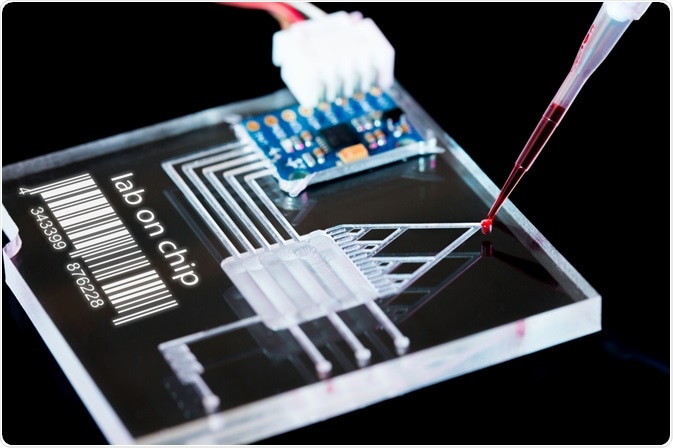BIOCHIP - Where LIfe Meets Technology

The working of Biochip mainly includes the following steps.
- Step1: The operator generates a low-power electromagnetic field through radio signals
- Step2: The fixed biochip gets turn on
- Step3: The activated chip transmits the identification code reverse to the operator through radio signals
- Step4: Reader strengthens the received code to change it into digital form and finally exhibits it on LCD.
The Biochip comprises two components namely the transponder as well as reader.
Transpoder
Transponders are two types’ namely active transponder and passive transponder. This is a passive transponder which means that it doesn’t contain any of its own energy or battery whereas in passive, it is not active until the operator activates it by giving it a low electrical charge. This transponder consists of four parts such as antenna coil, computer microchip, glass capsule, and a tuning capacitor.
- The computer microchip stores a unique identification (UID) number that ranges from 10 digits to 15 digits long.
- The antenna coil is very small, primitive and this type of antenna
- is used to send and receive the signals from the scanner or reader.
- The charging of the tuning capacitor can be done with the small signal i.e, 1/1000 of a watt which is sent by the operator.
- The glass capsule holds the antenna coil, capacitor, and microchip, and it is made with a biocompatible material namely soda lime glass.
1) DNA Microarray

A DNA microarray or DNA biochip is a set of tiny DNA spots fixed to a strong surface. A researcher utilizes to calculate the expression levels for a large number of genes. Every DNA mark comprises picomoles of particular genes which are termed as probes. These can be a short segment of a genetic material under high rigidity situations. Usually, probe-target hybridization is noticed and counted by recognition of fluorophore or chemiluminescence labeled targets to decide the relative quantity of nucleic acid series in the target. Innovative arrays of nucleic acid were macro arrays about 9 cm X 12 cm and the initially automated icon based analysis was published in the year 1981.
2) Microfluidic Chip

Microfluidic biochips or lab-on-a-chip are a choice to usual biochemical laboratories and are transforming several applications like DNA analysis, molecular biology procedures, proteomics which is known as the study of proteins and diagnostic of diseases (clinical pathology). These chips are becoming more complex by using 1000’s of components, but those components are designed physically called as bottom-up full-custom plan, which is a very large workforce.
3) Protein Microarray

A protein microarray or protein chip method is used to follow the actions as well as connections of proteins, and to find out their function on a large scale. The main advantage of protein microarray is that we can track a large number of proteins in parallel. This protein chip comprises of a surface for supporting like microtitre plate or bead, nitrocellulose membrane, the glass slide. In addition to this these chips are automated, rapid, economical, very sensitive, consumes less quantity of samples. The first methodology of protein chips was introduced in antibody microarrays of scientific publication in the year 1983. The technology behind this chip was quite easy to develop for DNA microarrays, which have turned into the most generally used microarrays.
Biochips Advantages and Disadvantages
- The biochip is used to rescue the sick
- Very small in size, powerful and faster.
- Biochips are useful in finding the lost people
- Biochips can be used to identify the persons individually
- Biochips perform thousands of biological reactions in a few seconds.
The disadvantages of Biochips include the following.
- Biochips are expensive
- Biochip raises dangerous problems of individual privacy.
- Biochip marks the end of human being liberty and self-respect.
- There will be a chance of turning every person into a controlled person
- Biochips can be fixed into the human’s body without their interference.
Biochips Applications
The applications of biochip include the following.
- By using this chip we can trace a person or animal anywhere in the world.
- This chip is used to store and update the information of a person like medical financial and demographics.
- A biochip leads to safe E-commerce systems
- These chips are effective in restoring the records of medical, cash, passport, etc.
- The biochip can be applicable in the medical field as a BP sensor, glucose detector, and oxygen sensor.
From the above-discussed information finally, we can conclude that biochips are accurate, fast, and miniaturized. The biochip space lies at the intersection between chip manufacturing, molecule biology, genomics, and signal processing . The market for Biochips and its applications has been increased in a number of core research regions.
As you have read it till now so please don't forget to follow this blog as I am uploading blogs everyday. Link to follow this blog- https://dailytechentertainment.blogspot.com/
Also If you want to know about anything related to technology and movies then please write in the comments.
Comments
Post a Comment